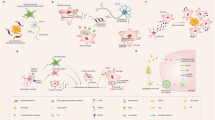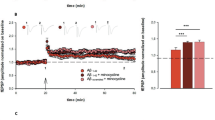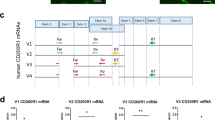Abstract
Microglia, the resident inflammatory cells of the CNS, are the only CNS cells that express the fractalkine receptor (CX3CR1). Using three different in vivo models, we show that CX3CR1 deficiency dysregulates microglial responses, resulting in neurotoxicity. Following peripheral lipopolysaccharide injections, Cx3cr1−/− mice showed cell-autonomous microglial neurotoxicity. In a toxic model of Parkinson disease and a transgenic model of amyotrophic lateral sclerosis, Cx3cr1−/− mice showed more extensive neuronal cell loss than Cx3cr1+ littermate controls. Augmenting CX3CR1 signaling may protect against microglial neurotoxicity, whereas CNS penetration by pharmaceutical CX3CR1 antagonists could increase neuronal vulnerability.
This is a preview of subscription content, access via your institution
Access options
Subscribe to this journal
Receive 12 print issues and online access
$209.00 per year
only $17.42 per issue
Buy this article
- Purchase on SpringerLink
- Instant access to full article PDF
Prices may be subject to local taxes which are calculated during checkout






Similar content being viewed by others
Change history
18 June 2006
replaced figure
Notes
*NOTE: In the version of this article initially published online, Figure 6a showed the wrong image. The error has been corrected for all versions of the article.
References
Harrison, J.K. et al. Role for neuronally derived fractalkine in mediating interactions between neurons and CX3CR1-expressing microglia. Proc. Natl. Acad. Sci. USA 95, 10896–10901 (1998).
Cook, D.N. et al. Generation and analysis of mice lacking the chemokine fractalkine. Mol. Cell. Biol. 21, 3159–3165 (2001).
Niess, J.H. et al. CX3CR1-mediated dendritic cell access to the intestinal lumen and bacterial clearance. Science 307, 254–258 (2005).
Geissmann, F., Jung, S. & Littman, D.R. Blood monocytes consist of two principal subsets with distinct migratory properties. Immunity 19, 71–82 (2003).
Jung, S. et al. Analysis of fractalkine receptor CX(3)CR1 function by targeted deletion and green fluorescent protein reporter gene insertion. Mol. Cell. Biol. 20, 4106–4114 (2000).
Haskell, C.A. et al. Targeted deletion of CX(3)CR1 reveals a role for fractalkine in cardiac allograft rejection. J. Clin. Invest. 108, 679–688 (2001).
Huang, D. et al. The neuronal chemokine CX3CL1/fractalkine selectively recruits NK cells that modify experimental autoimmune encephalomyelitis within the central nervous system. FASEB J. 20, 896–905 (2006).
Boehme, S.A., Lio, F.M., Maciejewski-Lenoir, D., Bacon, K.B. & Conlon, P.J. The chemokine fractalkine inhibits Fas-mediated cell death of brain microglia. J. Immunol. 165, 397–403 (2000).
Davalos, D. et al. ATP mediates rapid microglial response to local brain injury in vivo. Nat. Neurosci. 8, 752–758 (2005).
Nimmerjahn, A., Kirchhoff, F. & Helmchen, F. Resting microglial cells are highly dynamic surveillants of brain parenchyma in vivo. Science 308, 1314–1318 (2005).
Kreutzberg, G.W. Microglia: a sensor for pathological evets in the CNS. Trends Neurosci. 19, 312–318 (1996).
Nataf, S. et al. Brain and bone damage in KARAP/DAP12 loss-of-function mice correlate with alterations in microglia and osteoclast lineages. Am. J. Pathol. 166, 275–286 (2005).
Takahashi, K., Rochford, C.D. & Neumann, H. Clearance of apoptotic neurons without inflammation by microglial triggering receptor expressed on myeloid cells-2. J. Exp. Med. 201, 647–657 (2005).
Ito, D. et al. Microglia-specific localisation of a novel calcium binding protein, Iba1. Brain Res. Mol. Brain Res. 57, 1–9 (1998).
Hulshof, S. et al. CX3CL1 and CX3CR1 expression in human brain tissue: noninflammatory control versus multiple sclerosis. J. Neuropathol. Exp. Neurol. 62, 899–907 (2003).
Rivest, S. Molecular insights on the cerebral innate immune system. Brain Behav. Immun. 17, 13–19 (2003).
Carson, M.J., Reilly, C.R., Sutcliffe, J.G. & Lo, D. Disproportionate recruitment of CD8+ T cells into the central nervous system by professional antigen-presenting cells. Am. J. Pathol. 154, 481–494 (1999).
Rothwell, N. Interleukin-1 and neuronal injury: mechanisms, modification, and therapeutic potential. Brain Behav. Immun. 17, 152–157 (2003).
Zujovic, V., Benavides, J., Vige, X., Carter, C. & Taupin, V. Fractalkine modulates TNF-alpha secretion and neurotoxicity induced by microglial activation. Glia 29, 305–315 (2000).
Facchinetti, F. et al. Lack of involvement of neuronal nitric oxide synthase in the pathogenesis of a transgenic mouse model of familial amyotrophic lateral sclerosis. Neuroscience 90, 1483–1492 (1999).
Kust, B.M., Brouwer, N., Mantingh, I.J., Boddeke, H.W. & Copray, J.C. Reduced p75NTR expression delays disease onset only in female mice of a transgenic model of familial amyotrophic lateral sclerosis. Amyotroph. Lateral Scler. Other Motor Neuron Disord. 4, 100–105 (2003).
Chapman, G.A. et al. Fractalkine cleavage from neuronal membranes represents an acute event in the inflammatory response to excitotoxic brain damage. J. Neurosci. 20, RC87 (2000).
Meucci, O., Fatatis, A., Simen, A.A. & Miller, R.J. Expression of CX3CR1 chemokine receptors on neurons and their role in neuronal survival. Proc. Natl. Acad. Sci. USA [erratum appears in Proc. Natl. Acad. Sci. USA 98, 15393 (2001)] 97, 8075–8080 (2000).
Mizuno, T., Kawanokuchi, J., Numata, K. & Suzumura, A. Production and neuroprotective functions of fractalkine in the central nervous system. Brain Res. 979, 65–70 (2003).
Soriano, S.G. et al. Mice deficient in fractalkine are less susceptible to cerebral ischemia-reperfusion injury. J. Neuroimmunol. 125, 59–65 (2002).
Milligan, E. et al. An initial investigation of spinal mechanisms underlying pain enhancement induced by fractalkine, a neuronally released chemokine. Eur. J. Neurosci. 22, 2775–2782 (2005).
Milligan, E.D. et al. Evidence that exogenous and endogenous fractalkine can induce spinal nociceptive facilitation in rats. Eur. J. Neurosci. 20, 2294–2302 (2004).
Hoek, R.M. et al. Down-regulation of the macrophage lineage through interaction with OX2 (CD200). Science 290, 1768–1771 (2000).
Wright, G.J. et al. Lymphoid/neuronal cell surface OX2 glycoprotein recognizes a novel receptor on macrophages implicated in the control of their function. Immunity 13, 233–242 (2000).
Lesnik, P., Haskell, C.A. & Charo, I.F. Decreased atherosclerosis in CX3CR1−/− mice reveals a role for fractalkine in atherogenesis. J. Clin. Invest. 111, 333–340 (2003).
Hundhausen, C. et al. The disintegrin-like metalloproteinase ADAM10 is involved in constitutive cleavage of CX3CL1 (fractalkine) and regulates CX3CL1-mediated cell-cell adhesion. Blood 102, 1186–1195 (2003).
Cybulsky, M.I. & Hegele, R.A. The fractalkine receptor CX3CR1 is a key mediator of atherogenesis. J. Clin. Invest. 111, 1118–1120 (2003).
McDermott, D.H. et al. Association between polymorphism in the chemokine receptor CX3CR1 and coronary vascular endothelial dysfunction and atherosclerosis. Circ. Res. 89, 401–407 (2001).
Charo, I.F. & Ransohoff, R.M. The many roles of chemokines and chemokine receptors in inflammation. N. Engl. J. Med. 354, 610–621 (2006).
Sugama, S. et al. Age-related microglial activation in 1-methyl-4-phenyl-1,2,3,6-tetrahydropyridine (MPTP)-induced dopaminergic neurodegeneration in C57BL/6 mice. Brain Res. 964, 288–294 (2003).
West, M.J. New stereological methods for counting neurons. Neurobiol. Aging 14, 275–285 (1993).
Mitsumoto, H. et al. Effects of cardiotrophin-1 (CT-1) in a mouse motor neuron disease. Muscle Nerve 24, 769–777 (2001).
Acknowledgements
We acknowledge B. Trapp (Cleveland Clinic, Cleveland) for IBA-1 antibodies, W. Stallcup (Burnham Institute, La Jolla, California) for NG-2 antibodies, C. Canasto (Mount Sinai School of Medicine, New York) for technical assistance with CX3CL1 mice, R. Zhang (Mass Spectrometry Core II, Cleveland Clinic) for assistance with MPP+ measurements, C. Shemo (Flow Cytometry Core, Cleveland Clinic) for assistance with flow cytometry, and J. Drazba (Lerner Research Institute Imaging Core, Cleveland Clinic) for assistance with confocal microscopy. R.H. Miller (Case Medical School, Cleveland) provided helpful comments about the manuscript. This work was supported by the US National Institute of Health (NS32151), the Charles A. Dana Foundation, the National Multiple Sclerosis Society (fellowship FG1528-A-1 to A.C.), the Robert Packard Foundation for ALS Research at Johns Hopkins University and the Boye Foundation.
Author information
Authors and Affiliations
Contributions
A.E.C. performed the experimental design of the LPS and MPTP models, and carried out the microglia isolation, tissue staining and microglial transfer experiments. E.P.P. and V.K. carried out the experiments with SODG93A transgenic mice and assisted with manuscript preparation. M.E.S. and S.M.C. assisted in the maintenance of the mouse colony, genotyping, histopathological staining and neuronal counting. I.M.D. assisted in the development of the stereotaxic protocol. D.H. collaborated in the colocalization of lineage markers with the GFP reporter. G.K. assisted with the confocal analyses and imaging. S.D. assisted with stereology methods. R.D. collaborated in the analysis of the gene expression data from nuclease protection assays. J.-C.L. performed the statistical analyses for all experiments. D.N.C., S.J., S.A.L. and D.R.L. generated the highly inbred receptor- and ligand-deficient mouse strains, and assisted with the experimental design and manuscript preparation. R.M.R. provided the basis for the development of the experimental designs. A.E.C. and R.M.R. analyzed the data, interpreted the results and prepared the manuscript.
Corresponding author
Ethics declarations
Competing interests
The authors declare no competing financial interests.
Supplementary information
Rights and permissions
About this article
Cite this article
Cardona, A., Pioro, E., Sasse, M. et al. Control of microglial neurotoxicity by the fractalkine receptor. Nat Neurosci 9, 917–924 (2006). https://doi.org/10.1038/nn1715
Received:
Accepted:
Published:
Issue Date:
DOI: https://doi.org/10.1038/nn1715
This article is cited by
-
Fractalkine isoforms differentially regulate microglia-mediated inflammation and enhance visual function in the diabetic retina
Journal of Neuroinflammation (2024)
-
Microglia govern the extinction of acute stress-induced anxiety-like behaviors in male mice
Nature Communications (2024)
-
Exercise, Spinal Microglia and Neuropathic Pain: Potential Molecular Mechanisms
Neurochemical Research (2024)
-
Alzheimer’s genes in microglia: a risk worth investigating
Molecular Neurodegeneration (2023)
-
Microglial P2Y12 mediates chronic stress-induced synapse loss in the prefrontal cortex and associated behavioral consequences
Neuropsychopharmacology (2023)



